Reviews of books related to Australasian mining history and heritage are added by members. The Webmaster welcomes relevant new book releases and reviews from members and others interested in mining history. Active items may remain indefinitely. They are arranged in date order.
Latest Additions

THE TASMANIA GOLD MINING & QUARTZ COMPANY AT BEACONSFIELD 1877-1903: ‘A magnificent gold mine’
Nick Langsford 2024. Forty South Publishing. 240 pages, b/w and color photographs fully referenced and indexed. Can be ordered from Forty South Publishing or from the author (nlangsford@westnet.com.au). Price $49.95 + postage.
In the late 1870s there was a modest alluvial gold rush at Brandy Creek in the West Tamar district. This became an intense ‘reefing’ rush after the discovery in June 1877 by three Dally brothers of a gossanous and very rich vein system which became the famous Tasmania reef. The Dallys battled over-peggers and a Gold Commissioner initially reluctant to grant their leases, which were soon after sold to Launceston-based politicians who used their influence to acquire complete control of the astonishingly profitable reef. Mining was highly profitable until 1890. In 1903 amidst great acrimony among the directors, management, and shareholders, the mine was sold to British investors.The book is as much about the personalities of the discoverers and developers of, and investors in the reef as it is about the problems of mining the reef.

WHERE TREASURES SHINE: Lionel Gee South Australia’s forgotten identity
Judy Fander, 2023, Sturdee Press, 275 pp. lavishly illustrated including 12 colour photographs and 12 maps in colour. Softcover copies can be obtained from the author at
jfander@ozemail.com.au for $45.00 including postage in Australia. Overseas pricing on request.
This is the biography of Lionel Carely Egremont Gee, a significant South Australian public servant and Goldfields Warden. He was at goldfields in both SA and the NT, when the NT was administered by SA, including during rushes at Teetulpa and Tarcoola (SA) and later at Arltunga and the Tanami (NT). Rising from a cadet surveyor under Surveyor-general George Goyder, Gee became an important government administrator and occasional explorer. He worked closely with Government Geologist H.Y.L. Brown in the South Australia’s Geological Survey and the Department of Mines, overseeing mining legislation and departmental publications such as the Record of the mines of South Australia (1908) which remains a classic source of mining information.

RIO TINTO IN AUSTRALIA: The origins and formation of an international resources company 1954 – 1995
Robert Porter, August 2023, Connorcourt Publishing, 560 pp. hardback $65,
Rio Tinto in Australia charts the establishment and remarkable growth of Rio Tinto, including exploration in the 1950s, acquisition of the Mary Kathleen uranium deposit, and the 1962 combination with Consolidated Zinc to form Conzinc Riotinto of Australia (CRA). CRA was the major contributor to Australia’s post-war mining industry. Comalco aluminium, Hamersley iron ore and the major Bougainville copper operation were significant parts of the portfolio. Many individuals played a role in CRA’s development, among them legendary mining figure Sir Maurice Mawby, and Oxford and Harvard-educated Sir Rod Carnegie, who ultimately left the company when his quest for CRA’s independence and Australianisation fractured relations with London. RTZ and CRA combined in 1996 to form a dual listed company structure. The CRA name disappeared and Rio Tinto again became – as in 1954 – the identity of the Group in Australia.

POSTING TO MONGOLIA : A personal perspective
Andrew Cuthbertson, 2019, published by the author and distributed by Amazon.com.au in electronic Kindle ($11.99) and paperback ($7.30) formats.
Posting to Mongolia is a firsthand account by Australian geologist Andrew Cuthbertson of his experiences in Mongolia between 2004 and 2008. The book outlines the land and people as the country opened up to Western exploration and mining companies following the collapse of the former USSR. It describes the establishment of Rio Tinto in Mongolia and the geopolitical, commercial, social, and technical efforts of Australian professionals in partnership with the governments of Australia, the UK, Canada, the USA, Japan, and Germany in the early mine development of the largest then known undeveloped copper-gold deposit in the World at Oyu Tolgoi. The book has been described as the “best documented case study of a multinational mining company entering a developing country blessed with a world class mineral deposit”.

THE TASMANIA GOLD MINE
Nick Langsford 2022. Published by Forty South. 168 pp., b&w and colour photographs. Fully referenced and indexed. Copies can be ordered from the author at nlangsford@westnet.com.au. Price $40 plus postage.
In 1903 a British shell company took over the ailing Tasmania Gold Mine at Beaconsfield, Tasmsnia. The take- over was engineered by John Taylor and Sons, who took control of the management. The book describes the financial manoeuvres involved and the subsequent mine development under the Taylor management. Three very large steam pumps built by Hathor, Davey were installed in grandiose engine houses. The book describes in the construction and operation of the plant and the two major shaft complexes, up to its closure in 1914. Numerous b&w glass plate images of the construction work are published for the first time.

OUTSIDE MINES OF THE BROKEN HILL AREA
Geoff Randall, 2022, Published by Geoff Randall, 306 pp. plus b&w and colour photos. Paperback price $70 plus postage ($12 in Australia). To purchase a copy contact the author at emaust15@bigpond.com
The Outside Mines of the Broken Hill Area traces the development of now abandoned mine sites and townships surrounding Broken Hill in western New South Wales. It also describes the social histories and the technologies which rapidly evolved as pioneers moved through the Barrier Ranges. The Broken Hill Main Lode is well known, but little has been documented about the hundreds of mining sites and scattered villages which also occur in the district, a gap which this book addresses. See JAMH Vol. 20 for review.

FOSSICKING AFAR
Richard Mazzucchelli, 2022, Footprints Publishing, 203 pp. plus photos and family tree, Paperback. Copies available from the author for $20.00 plus $7.00 (in Aus) postage and packaging. Contact mazzrich@bigpond.net.au
A young immigrant from an impoverished village in southern Switzerland finds love in Victoria, gold in New Zealand and fulfilment in the goldfields of Western Australia. Fossicking Afar is a creative non-fiction story, based on the life of the author’s great grandfather. See JAMH Vol. 20 for review.

ECHO FOXTROT: Journeys through Papua New Guinea and South-East Asia
Andrew Cuthbertson, 2021, published by the author, 372 pp. Paperback price $60.63, kindle $11.99. Available from Amazon.com.au.
Echo Foxtrot is the third book in a trilogy documenting the professional life of Andrew Cuthbertson, an experienced frontier explorer and geologist. It follows the earlier books Posting to Mongolia and Mary Kathleen Reflections, which both received international acclaim. The book covers the author’s experiences in Papua New Guinea, Indonesia and the Philippines while working for the Rio Tinto and Freeport Indonesia Groups.

OK TEDI MINING
Multiple Authors, 2020, OTML and Australian Institute of Geoscientists, hard cover $106, soft cover $91 including Australian shipping. Available through AIG at:
https://www.aig.org.au/publication-shop/ok-tedi-mining-soft-cover/
2018 was the 50th anniversary of discovery of the Ok Tedi porphyry copper-gold deposit in Papua New Guinea. In commemoration, Ok Tedi Mining, in collaboration with AIG are publishing an anniversary volume with over 30 articles and many historical photographs written and collected by geologists, surveyors, field technicians, lawyers, pilots and other professionals who were there and have first-hand experience.
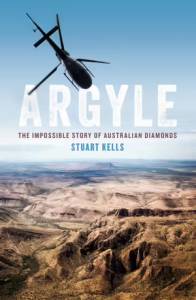
ARGYLE: The Impossible Story of Australian Diamonds
Stuart Kells, 2021, Melbourne University Press, 320 pp., paperback price $29.69.
This is the story of the discovery and development of the Argyle diamond deposit, the largest known diamond pipe in the world and the source of rare pink diamonds. The book details the almost overwhelming challenges with realising a diamond mining venture in Australia, shows how these obstacles were overcome, and explores the mine’s impact and legacy.

THE HISTORY OF THE GIPPS CREEK TIN FIELD
Volker Hahl, 2021, published by the author, 120 pp. Soft cover, maps and photos. Price $20 plus $10 postage. Contact pasquan@icloud.com
Gipps Creek was a small and remote tin field located to the south west of the Ben Lomond plateau and north west from Avoca off the Fingal Valley. Discovered in 1881 amid much interest and excitement in mining circles it had passed its heyday by the early 1920s. But it did not die completely. Tin scratching and fossicking continued until the late 1980s. This book tells the story of the field.

OF EARTH, FOR EARTH: The meaning of a mine
Kathryn Moore, Dana Finch, Bridget Storrie (editors), 2020 Waterstones. Exeter. UK. 116 pp. Hard cover, full colour. Price £22.
With insight and empathy from numerous contributors, this rich and very serious conversation among artists, community members, industrialists and educators will inspire debate.
A “must read” for anyone concerned with the sustainability of mining on the Earth, especially as minerals that come out of the ground are critical to achieving a green future.

INNOVATION, GREED AND A LONG, LONG, TWILIGHT: A History of New Zealand Crown Mines Co. Ltd. (1883-1994)
M.K. Rimmer, 2020, Hamilton: Print House, 860 pp. Hard cover price: NZD150. Contact: l1br2y@gmail.com.
This book describes the convoluted tale of the New Zealand Crown Mines Co. Ltd., a large, British-funded, underground gold-mining company which exploited ore deposits at Karangahake on New Zealand’s Coromandel Peninsula. The Company achieved international fame by introducing the MacArthur-Forrest Process of gold extraction using potassium cyanide (KCN) into the hard-rock gold mining industry. For a time, the mine was one of New Zealand’s largest gold producers and although mining ceased in 1927 and the company left New Zealand in 1954, the ‘Crown had a subsequent 40 year career as a prominent investment company. A fascinating tale.

MINER WITH A HEART OF GOLD: Biography of a Mineral Science and Engineering Educator
Franklin White, 2020, FriesenPress, 256 pp. Available in print and ebook versions. For details see https://www.franklinwhiteauthor.com/
Frank White played a visionary role for mining and metallurgy during the twentieth century. His life of advocacy, adventure and insight was often lived against the backdrop of social and economic turbulence. His story connects the histories of Australia, New Zealand, Fiji, Malaysia, and Canada. He believed that mining is not simply about digging out the ore but an essential beginning for complex processes that affect virtually everything, and that how well this is done matters for everyone. Frank White was best known in Australia as founding professor of Mining and Metallurgical Engineering at the University of Queensland, which gained prominence in the field in part through its development of the UQ Experimental Mine, which became the platform for the Julius Kruttschnitt Mineral Research Centre. In 1965, Frank was sought out to rebuild North America’s oldest school of mines at McGill University; he passed away in Montreal in 1971.
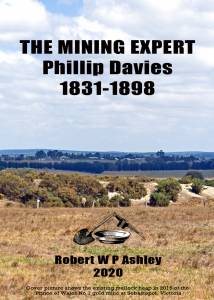
THE MINING EXPERT: Phillip Davies 1831-1898
Robert Ashley, 2020, Robert WP Ashley, Wendouree. 398 pp. 195 diagrams, maps and photographs, $87.00 plus $13.00 for postage from PO Box 128, Wendouree, Victoria, 3355. Limited edition of 150 copies.
Phillip Davies was an experienced miner, manager, mine owner, investor, inventor , company director and an expert mining investigator. This book covers Davies’ life from being a coal miner in South Wales, to part owning one of the most innovative and productive gold mines in NSW and his later association with John Howell of Broken Hill fame. Davies’ investigations into coal, copper, gold, shale and tin deposits across Australia form an important focus. It is a detailed epic which will reward the patient reader with new insights into the fabulous mining history of the Australian colonies.

CONSOLIDATED GOLD FIELDS IN AUSTRALIA: The Rise and Decline of a British Mining House, 1926–1998
Robert Porter, 2020, ANU Press, Canberra, 484 pp. 54 images, 36 charts & tables. Download or view free copy at https://press.anu.edu.au/publications/consolidated-gold-fields-australia or order a print copy $70.
This history charts the story of the Consolidated Gold Fields of South Africa, a major British mining house, and its activities in Australia. It chronicles the main stages of the evolution of Consolidated Gold Fields in Australia, reviews the main elements in its portfolio, and examines some of the factors that impeded achievement of the lofty ambitions of its founders and management in Australia. The company had an involvement in the Western Australian gold sector from the 1920s and held investments in the Mount Lyell Mining and Railway Company, in Renison, in iron ore in the Pilbara, mineral sands, as well as a range of other interests.

MARY KATHLEEN REFLECTIONS: A loss of innocence working at a uranium mine in the Australian outback
Andrew Cuthbertson, 2020, published by the author distributed by Amazon.com.au in electronic Kindle and print formats, 95 pp., 2 maps and 41 colour photographs, price $34.
This book is for those interested in exploring the “ghost town” of this famous mine, located between Mt Isa and Cloncurry in Northwest Queensland. Through his experiences as a young mine geologist entering the workforce for the first time, the author provides observations, often humorous, of a remote mine and the tight-knit community that it supported. The reader is given an understanding of what it was like for three generations of miners and their families who called Mary Kathleen a home. The book has a rich selection of previously unseen photographs of the mining operation and township taken during the final year of operation between 1981 and 1982.

COAL: The Australian Story – Volume 2 1970 to 2020
Denis Porter, 2020, Connor Court Publishing, 491 pp.
The second volume of Coal: the Australian Story covers many of the major events, controversies and stories about the industry in NSW and Queensland, including industrial conflicts, foreign investment, export contracts and prices, major government inquiries, mine developments and safety. The period covered by this volume has seen the industry develop into a world class industry and major export earner for Australia, although the development of the industry has not been smooth or painless. Some of the controversies have now faded, only for the future of coal to be the subject of intense debate in terms of its role in climate change. See review JAMH Vol. 19, pp. 173-174.
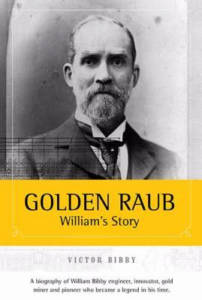
GOLDEN RAUB; Williams Story, the Life and Times of William Bibby (2nd Edition)
Victor Bibby, 2016, Vivid Publishing, 448 pp., paperback, $29.95 and $11.50 P+P. Available from Vivid Press, http://www.vividpublishing.com.au/williamsstory/
Unmarked and forgotten graves, an old pickle jar, a stamp shoe worn to a slipper, abandoned mines in Victoria and remotest Queensland, floods and rebellion. All are stops and clues along the way as Victor Bibby treads in the footsteps of a gold mining pioneer to discover long-lost relatives and the truths about his own family. Bringing alive an historical account of life on the goldfields and events that made colonial history. A fascinating tale of a toolmaker from industrial England who created a new life in Australia as an engineer, innovator and gold miner before struggling against the odds to find fame and fortune as a mining pioneer in the Malayan jungle.

THE WORLD TURNED UPSIDE-DOWN
The Australian goldrush as told though song, story and reminiscence Warren Fahey, 2013. Available as an e-book for $20 from the Apple iBookstore (free sample chapter available) or as a PDF that can be read on any computer. For the downloadable PDF, email wfahey@bigpond.net.au. Fahey is a well-known folklorist and performer of traditional Australian folk songs. The book has wonderful stories about the chaos of the first rushes, emigration, life on the goldfields, authority, bushranging and the later company mines. Over 135 songs, many newly discovered by Fahey, plus many great images from the archives. The e-book has bonus audio tracks, including some from Fahey’s early collecting period. AMHA members purchasing the PDF will also receive some bonus audio tracks.

LINES, MINES, PEOPLE AND PLACES
Barry Sykes, 2012. Barry Sykes, Traralgon, 895 pp., approx. 2000 ill., maps, photos, A4, $80 plus postage. To order contact Barry Sykes directly (basykes@optusnet.com.au).
This large and well-presented publication provides an encyclopaedic history of the South Gippsland area. The first half covers the exploration of the area, and its social history, whilst the second half contains a detailed study of the coal mines and the railways that served them. It has no index, but instead has a greatly amplified Table of Contents which extends to over 10 pages for easier reference, and all footnotes are incorporated into the text. It contains an extensive Bibliography; and all sources of images are provided where known.

BLACK GOLD
Aboriginal People on the Goldfields of Victoria, 1850-1870
Fred Cahir, 2012. ANU E Press and Aboriginal History Incorporated, 152 pp. 15 ill., print version $24.95. Order a print on demand copy. Also available as a FREE DOWNLOAD.
The first history of Aboriginal-white interaction on the Victorian goldfields, Black Gold offers new insights on one of the great epochs in Australian and world history-the gold story. In vivid detail, it describes how Aboriginal people often figured significantly in the search for gold and documents the devastating social impact of gold mining on Victorian Aboriginal communities. It reveals the complexity of their involvement from passive presence, to active discovery, to shunning the goldfields. Running through this book are themes of Aboriginal empowerment, identity, integration, resistance, social disruption and communication.

MINING TOWNS: Making a living, making a life
Erik Eklund, 2012. University ofMak NSW Press, 23.4×15.3mm, 400 pp. p/back, $49.99. To order.
At any given moment in our history Australia has been in the middle of a mining boom. This timely book is a history of the iconic Australian towns that arose with these booms over a century: Broken Hill, Mount Isa, Queenstown, Mount Morgan, Port Pirie and Kambalda. Mining Towns shows the rich cultural and historical legacy these towns helped create as townspeople – those working below the ground and those above – sought to make their lives in them. Review
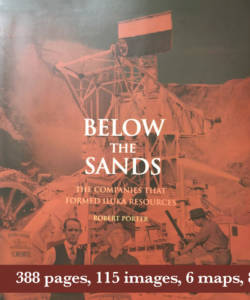
BELOW THE SANDS: The companies that formed Iluka Resources
Robert Porter, 2018, RPIR Cotham, 388 pp. 115 images, 6 maps. Limited print run. Price $45.00 including postage within Australia. Available from rpir@iinet.net.au
Below the Sands charts the formation of Iluka Resources in 1998, through the amalgamation of the lineage of two streams of companies: Consolidated Gold Fields Australia (CGFA) and then Renison Goldfields Consolidated (RGC), with Westralian Sands. The book conveys the complex and intriguing history of both sets of companies, including the events, which led RGC to have corporate raider, Hanson Plc, as its major shareholder. Westralian Sands approached Hanson suggesting an aggregation of the two companies and Iluka was formed in 1998. The book explores the lead up to these events and the post-acquisition period to 2015. See review by David Lee in JAMH Vol.16.

RUSHING FOR GOLD
Lloyd Carpenter & Lyndon Fraser (Eds) 2016 Otago University Press 344 pp.
Rushing for Gold is the first book to take a trans-Tasman look at the nineteenth-century phenomenon that was the gold rushes in Australia and New Zealand. It explores links between the rushes, particularly those in Victoria and Otago, to show that they were strongly intertwined affairs. Edited by Lloyd Carpenter and Lyndon Fraser, the book brings together contributions from both experienced and newly emerging researchers. To obtain copies of the book see: https://www.otago.ac.nz/press/otago291003.pdf

CAPTAIN BAGOT’S MINE: History of the Kapunda Mine 1844-1916
Greg Drew, 2017. Published by the author, Adelaide SA, A4, 192 pp.
In Captain Bagot’s Mine Greg Drew has prepared an engaging essay, capturing every turn in the legal, technical, financial, and social aspects of this piece of South Australian history. Well documented and nicely illustrated, the book is, too, a fascinating case study of the development of a mining enterprise in a distant new land, attracting as it did from afar the technical specialists and skilled labourers essential to success. Normally $49.95 but $39.95 from the author plus postage, email gldrew@internode.on.net See special deal for AMHA members on For Members page.
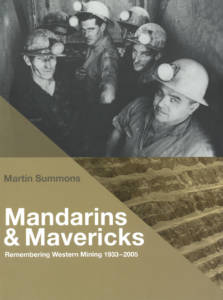
MANDARINS AND MAVERICKS: Remembering Western Mining 1933-2005
Martin Summons, 2017. Hardie Grant Books 396 pp.
Mandarins and Mavericks is a story of drive and endeavour by the people who built and sustained Western Mining Corporation, ultimately named WMC Resources Ltd., from its origin in 1933. Drawing on the voices of many of the individuals involved, the book traces the company’s progress throughout its 72 years from its humble start in a corporate world far different from that of today, to its steady, but at times faltering growth and eventual ranking as one of Australia’s leading exploration, mining and processing conglomerates. As well as a history of Western Mining it is a story that reflects the development of the modern Australian mining industry. See review by Erik Eklund in JAMH Vol. 17.

AUSTRALIA’S NICKEL ADVENTURE
Ross Louthean and Carl Kim Robinson, 2018, Vanguard Press 188 pp.
This book is a concise and engaging history of nickel exploration and mining in Australia. There are 46 short chapters, each essentially a self contained and easy to read story describing a particular event, company or development in the complete history from prior to the nickel boom of the 1960-70s to the present day. There is a strong focus on the human dimension and the diverse characters who populated {and in some cases still do} the great Australian ‘nickel adventure’. See review by Jon Hronsky.

THE SECOND RUSH: Mining and the Transformation of Australia
David Lee, 2016, Connor Court Publishing, 463 pp.
The Second Rush is a history of the minerals boom in Australia over the half century from the 1960s to the end of the China driven minerals boom in 2012. The earlier gold rush boom of the nineteenth century created extraordinary prosperity. However, from 1901 to the 1950s, with a few exceptions, mining descended into the doldrums. In the 1940s mining was regarded as belonging to Australia’s past and not to its future. Beginning in the 1960s a second phase of mineral booms put paid to this notion and again underpinned the prosperity of the nation. The book examines the explorers, financiers, managers and engineers, mining companies and their relationship with governments, workers and industrial relations and the impact of mining on the environment and on Australia’s first peoples. See review by Bradon Bowen in JAMH Vol. 15.

.
COAL: THE AUSTRALIAN STORY – from convict mining to the birth of a world leader
Denis Porter, 2019, Connor Court Publishing, 403 pp.
Coal: the Australian Story traces the development of the industry from the early days of the Colony, through Federation and the period to the Second World War, then to the post war period when the industry began to be modernised, and finally to the 1960s when the industry was starting out on its transformation to one increasingly focussed on the export market. The book concentrates on NSW and Queensland, the states with by far the largest coal mining industries and the scenes of the major industrial battles, and where foreign investment has played such a major and often controversial role. These states have also seen unique or special regulation through coal boards and the industry’s industrial tribunal which was separate from the mainstream industrial relations system for so many years.
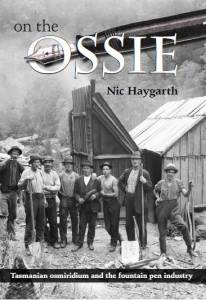
ON THE OSSIE: Tasmanian osmiridium and the fountain pen industry
Nic Haygarth
Forty South Publishing, Hobart, 2017, 277 pages, paperback. Available for $54.95 (including postage) at https://nichaygarth.com/index.php/portfolio/
Millions of words flowed from the serpentine hills of western Tasmania. The Waratah and Adamsfield districts produced ‘point metal’ osmiridium, used to tip the gold nibs of fountain pens. For a time in the early 1900s Tasmania had a world monopoly on point metal ‘ossie’—an alloy much more valuable than gold. Sent to New York and London to drive Waterman, Swan, Sheaffer, Parker, Onoto and Conway Stewart pens, Tasmanian osmiridium became a signatory to startling world events. It also bolstered family budgets at home. To be ‘on the ossie’ was to have the chance to escape poverty and drudgery. Like gold strikes across the globe, Tasmania’s precious metal quickened diggers’ pulses—and, astonishingly, inspired a challenge to Hollywood dominance of Australian cinemas. See review by Matthew Churchward JAMH Vol. 16.

NO ROYALTY NO DEAL
Karl Wolzak, 2019. 309 pages with maps, diagrams and photos. paperback. $25.50 plus postage. To order go to www.karlwolzak.com or karl.wolzak@westnet.com.au
Bill Allen was a modern day prospector utilising the old time prospectors art of loaming, taught to him by Sam Cash famously known as “The Prince of Loamers”. Despite great adversity in his life Bill went on to discover two significant gold resources in the Eastern Goldfields of Western Australia. His major discovery was the Golden Cities mine which to this day remains the second largest gold in granite resource in the world. The book also chronicles some of the major mining centres in Western Australia where he lived and worked.

NOT A POORMANS’S FIELD
Michael Waterhouse, 2010, Halstead Press, Canberra, 224 pp. hard cover.
Not a Poor Man’s Field explores Australia’s colonial experience in New Guinea before World War II. This is a dramatic account of small miners, an extraordinarily rich gold discovery, visionaries and the construction of giant dredges, power stations and townships in a remote jungle area. It is also the story of how risk-taking pilots, flying aeroplanes ranging from single engine plywood biplanes to large Junkers G31 freighters, opened up an otherwise impenetrable country. New Guinea led the world in commercial aviation throughout the 1930s.
